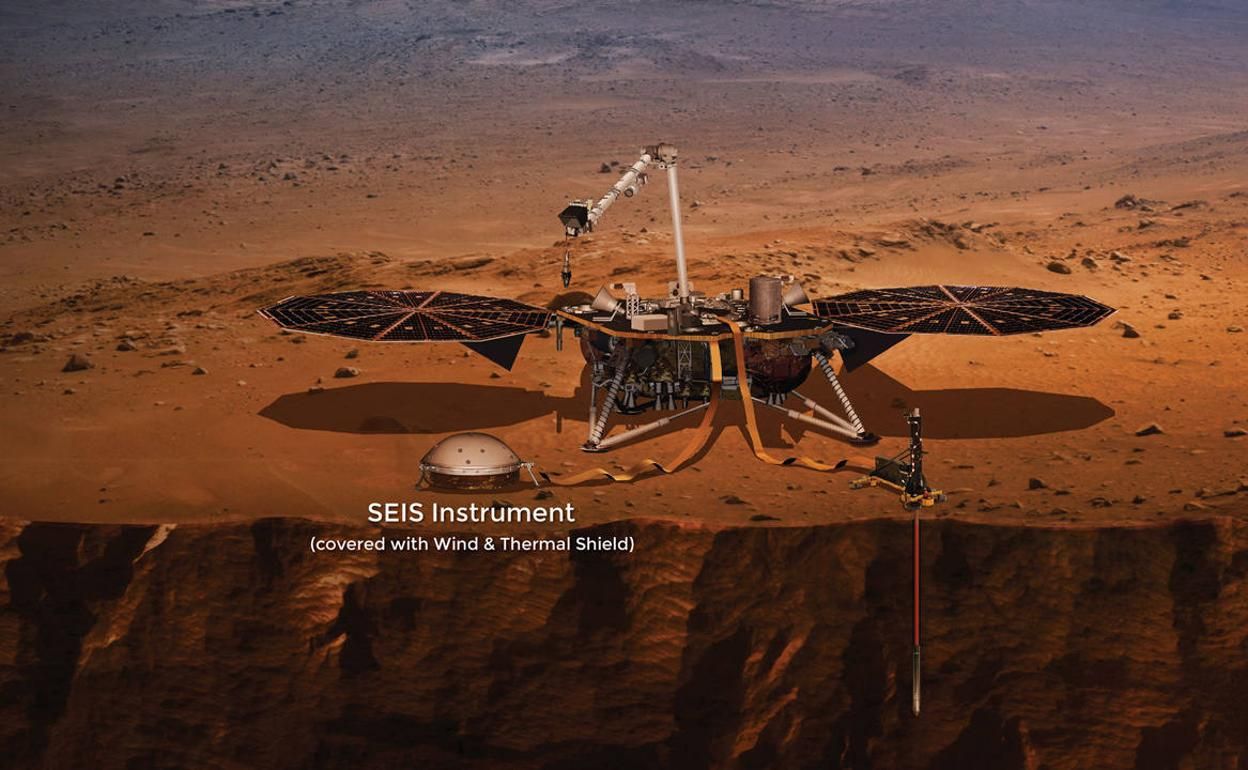
Let’s come back to our own solar system and talk about another mission to the red planet, NASA’s InSight. We’ve been calling it that for so long now that even I have forgotten it’s an acronym — Interior Exploration using Seismic Investigations, Geodesy and Heat Transport. This mission is designed to search for answers about the interior structure of Mars and the planet’s formation/evolution, plus gather data on tectonic activity and meteorite impacts.
InSight was launched in May 2018 from Vandenberg Air Force Base here in California. It took six months to get to Mars and landed on November 26. Upon landing, InSight had to unfurl all its solar panels, which are two fan-like discs on either side of the lander. Then all the other instruments had to be checked out and tested, pictures of the landing site were taken, and it took about ten weeks before the real science began.
One of those instruments is a seismometer named SEIS, for Seismic Experiment for Interior Structure because everything needs an acronym. Atop the instrument is a protective dome to spare the instrument the effects of wind and temperature. In the first year alone, SEIS detected more than 450 seismic signals, most of which were marsquakes. The largest of those was about a 4.0 in magnitude; interesting in and of itself, but not big enough to travel below the crust and into the mantle and core to give us any information about Mars’ interior.
We know that Mars doesn’t have tectonic plates like Earth, but it does have volcanically active regions, and those regions can cause marsquakes. During that first year of operations, InSight detected two quakes in the Cerberus Fossae region that measured 3.6 and 3.5. And just this past week, NASA announced that InSight detected two more strong quakes in the same region, measuring 3.3 and 3.1 magnitude. They’re still not big quakes, but they are very clear signals that lead scientists to believe that this region is a center for seismic activity on Mars.
What makes these four quakes so interesting is that they are Earth-like quakes. Researchers have divided the marsquakes into two distinct types based on their physical properties, such as the course of travel. Earth-like quakes travel directly through the planet, while Moon-like quakes tend to be more scattered. Honestly, most marsquakes have tended to be a bit in between the two types, but these four are definitely Earth-like.
Another fascinating piece of these most recent detections is that they were, like the previous two quakes, recorded during the Martian northern summer. Winter on Mars is windy…ish. The dome on the seismometer does cut down on the wind, but that wind is noisy enough that the vibrations caused by it obscure any marsquake detections. Over this past Martian northern winter, no quakes were detected at all. Once the winds quieted down, we heard these two new quakes.
We mentioned that the dome also protects the seismometer from Martian temperatures, which can fluctuate from -100 degrees Celsius to 0 degrees Celsius. While the instrument is protected, those extreme variations lead to popping sounds and even spikes in the data. So the mission team is trying to insulate the cable from the weather by using InSight’s robotic arm to drop Martian soil on top of the dome. The soil then trickles down to cover the cable and provide some more insulation but doesn’t interfere with the shield’s seal with the ground.
This mission is kind of amazing because they keep having to problem solve from a distance. First, there was the mole that was trying to dig underground but the dirt wasn’t a good consistency. They tried everything they could before they finally stopped that portion of the mission. Now they’re trying to improve an instrument on another planet using only the lander and the surrounding dirt. And they’re about to combat another force of nature — lack of sunlight. The solar panels, like those of Spirit and Opportunity before, are covered in dust, and Mars is moving away from the Sun. It’s expected that InSight will hibernate until after July, but the SEIS team is hoping to keep their instrument on for another month or two.
As always, we’ll bring you updates on the analysis of these quakes and the status of InSight this summer as they are published.
article originally appeared on Cosmoquest on April 8, 2021





